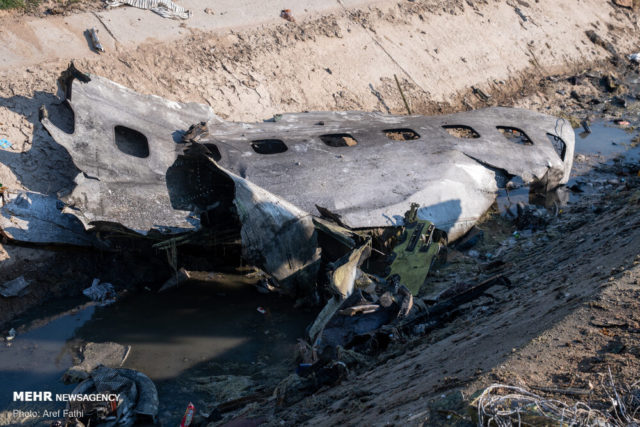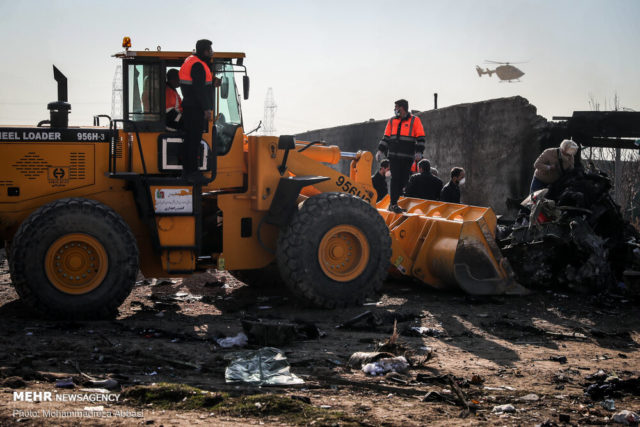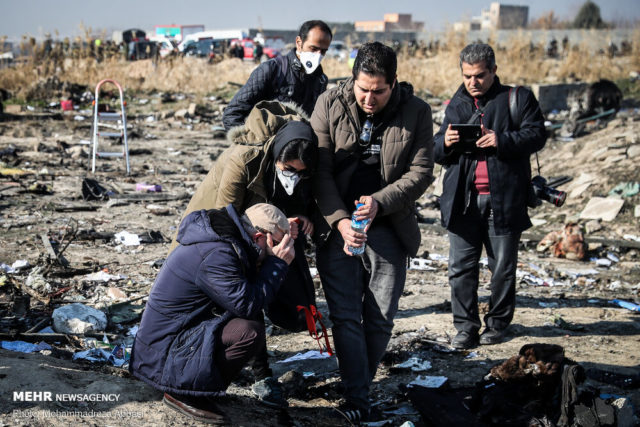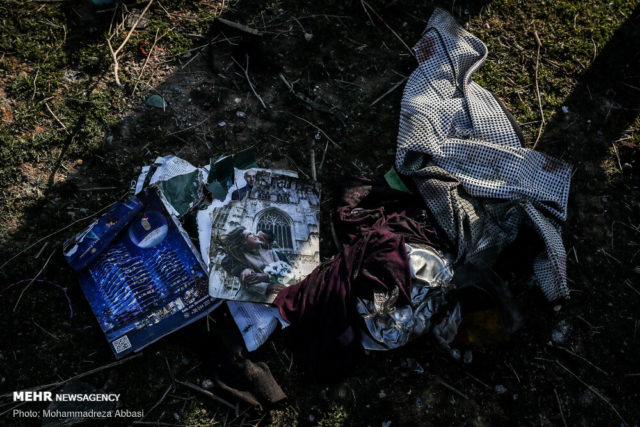Shoot Down of Ukraine International Airlines flight 752
On Wednesday the 8th of January 2020, Ukraine International Airlines flight 752, a scheduled passenger flight from Tehran to Kiev, suffered a catastrophic failure directly after take-off.

The aircraft was a Boeing 737-800 registration UR-PSR with 167 passengers and nine crew members on board.
The aircraft departed Imam Khomeini International Airport on runway 29R at 06:13 and began to climb to its approved cruising altitude of 26,000 feet. At 06:18, five minutes after departure, the aircraft crashed at the outskirts of Tehran. There were no survivors.
The Aircraft Accident Investigation Board of Iran released a preliminary report the day after the accident.
Initially, the aircraft climbed to an altitude of 8’000 feet and turned to the right, when it disappeared off the approach radar scope, and by losing height, it impacted the ground and disintegrated. No radio communication indicating the unusual conditions was received from the pilot.
According to witnesses (people on ground as well as the crew of the passing
flights in higher altitudes observing and reporting the event), a fire appeared on the aircraft which was intensifying, then impacted the ground causing an explosion.The crash site track indicates that the aircraft was first approaching west to exit the airport boundary, but turned right following a technical problem, and had a track showing returning to the airport.
As per ICAO Annex 13, Ukraine, NTSB of the US, Sweden’s SHK, Canada’s TSB and Afghanistan’s CAO were contacted. A representative from Ukraine had arrived at the site before the preliminary report was released.
It wasn’t long before the Iranian version of events came under fire. The US cited evidence that the flight had been shot down by an Iranian Tor missile, which the Iranians initially claimed was an American lie and “an attempt to prevent Boeing stock from a free fall”. British defence officials and Canada’s prime minister weighed in, agreeing that based on the evidence they had seen, the aircraft did not suffer a technical fault but instead was shot down.
On the 11th of January, the Islamic Revolutionary Guard Corps admitted that the aircraft had been shot down after a controller mistakenly identified it as a US cruise missile.
This security footage video posted on Tuesday the 14th shows two missiles hitting the aircraft, thirty seconds apart. The New York Times says they have verified the footage.
The date visible on the footage does not match but the New York Times state they believe that it is because the camera system is using a Persian calendar rather than a Gregorian one.
January 8 converts to the 18th of Dey, the 10th month in the Persian calendar. Digitally that would display as 2019-10-18 in the video. One theory is that the discrepancy of one day can be explained by a difference between Persian and Gregorian leap years or months.
On the same day, CNN reported that Iran’s judiciary announced that an investigation into the crash had started and that several arrests had been made. One of them was a person who filmed the scene of the missile hitting the aircraft.
One issue that I’d like to dismiss is the fuss that the Iranian Aircraft Accident Investigation Bureau refused to hand the “black boxes” (sorry Rudy) to Boeing for analysis. I’ve seen this all over the popular press and I have no idea where the idea started that this was an issue or part of a cover-up.
Boeing have been invited to participate in the investigation, as one would expect. There’s no reason why they should be handed primary evidence from the wreckage and indeed, I can think of a number of reasons why they absolutely should not. There is no obligation to hand the recorders to the US authorities and again, given the current political situation, I hardly find it surprising that Iran would not want to trust US authorities. There are all kinds of irregularities in this case, but this is not one of them.

The Ukrainian authorities have asked for access to the flight recorders and to have their experts decrypt them but as of the 15th had not received a clear answer.
I had originally guessed that Iran would ask the French BEA to download and analyse the recorder data but it may be that the Canadian TSB will be invited to handle this aspect of the investigation.
TSB’s role in the investigation of Ukrainian Airlines flight 752
Since learning of the accident, the [Canadian] TSB has been in direct contact with the Aircraft Accident Investigation Bureau (AAIB) of the Islamic Republic of Iran. Given the high number of Canadian fatalities, the TSB has confirmed its role as an expert and accepted Iran’s invitation to attend the accident site as entitled in Annex 13 to the Convention on International Civil Aviation. Two TSB air accident investigators left Canada on Friday evening and, over the weekend, met up with members of the Canadian consular team in Turkey. They have since obtained visas to travel to Iran and have departed for Tehran, along with members of Canada’s Consular team. Additionally, the TSB will also deploy a second team of investigators with expertise in aircraft recorder download and analysis, once the time and place that this activity will take place is confirmed.
Note the use of the term expert as opposed to accredited representative. This language is clearly described in ICAS Annex 13. The Canadian TSB is invited because of the fatalities of Canadian citizens. This gives them the right to visit the scene of the accident and have access to relevant factual information as approved by the Iranian TSB and a copy of the final report.
It does not give them the right to have full access to the evidence or to participate in the investigation or even to examine the wreckage. Although they state above that they plan to deploy investigators with expertise in aircraft recorder download and analysis, it is completely up to the Iranian AAIB to invite them to participate in that part of the investigation. The lack of response to the Ukrainian authorities regarding the plans for the data recorders makes this point a worrying one.

This opinion piece by RAF pilot Paul Kennard gives a quick rundown as to the sequence of events that brought us to this point. It’s slightly out of date but is still, I think, well written and with good detail.
Forbes: Ukraine International Flight PS 752: A Shakespearean Tragedy?
The past couple of weeks have played out like some macabre adaption of the Bard’s greatest works. The opening scene was the attack on the US Embassy in Baghdad by Iranian backed militias recruited, trained and directed by Major General Qasem Soleimani of the Islamic Revolutionary Guard Corps (IRGC).
Those who can read Russian might be interested in this article, in which a Radar development engineer argues that such a mistake would be impossible to make.
Novaya Gazeta: Все-таки «обезьяна с гранатой»
My Ukrainian friend Leo has translated the passages for us:
Самолет взлетел с гражданского аэродрома и пошел по стандартной трассе. Пассажирский самолет не может лететь абы как, он идет по выделенному коридору. Командир экипажа ЗРК должен видеть, что цель идет в коридоре, выделенном под пассажирские самолеты. Уже это одно должно ему показать: перед ним не какой-то американский беспилотник, а гражданский лайнер.
The airplane took off from a civilian airfield, on a standard route. A passenger plane cannot fly just anywhere; it follows a dedicated corridor. The air defense commander should see that the target follows a corridor allocated for passenger aircraft. This alone should show him: this is not some American drone but a civilian airliner.
— Перепутать пассажирский самолет с крылатой ракетой не мог бы никто и ни при каких обстоятельствах. Разве что это была не просто «обезьяна с гранатой», а пьяная обезьяна с гранатой.
No one, under any circumstances, would have confused a passenger plane with a cruise missile. Only a monkey with a grenade could have done that–and not even that, but a drunk monkey with a grenade.
There’s one other potential spanner/wrench in the works. Is there any requirement for an investigation under Annex 13?
Dave Reid, whose photographs have often graced these pages, pointed out on PPRuNe that Annex 13 specifically excludes incidents involving injury or death inflicted by a third party.
I’m not sure this is stated explicitly but it is true that the point of an ICAO investigation is to prevent accidents and incidents and not to apportion blame, which a criminal investigation does not support.
Here’s an excerpt of the ICAO definition of an accident, paying special attention to the exception clause of point a.
An occurrence associated with the operation of an aircraft which, in the case of a manned aircraft, takes place between the time any person boards the aircraft with the intention of flight until such time as all such persons have disembarked, or in the case of an unmanned aircraft, takes place between the time the aircraft is ready to move with the purpose of flight until such time as it comes to rest at the end of the flight and the primary propulsion system is shut down, in which:
a) a person is fatally or seriously injured as a result of:
– being in the aircraft, or
– direct contact with any part of the aircraft, including parts which have become detached from the aircraft, or
– direct exposure to jet blast,
except when the injuries are from natural causes, self-inflicted or inflicted by other persons, or when the injuries are to stowaways hiding outside the areas normally available to the passengers and crew; or
b) the aircraft sustains damage or structural failure which:
– adversely affects the structural strength, performance or flight characteristics of the aircraft, and
– would normally require major repair or replacement
except for engine failure or damage, when the damage is limited to a single engine (including its cowlings or accessories), to propellers, wing tips, antennas, probes, vanes, tires, brakes, wheels, fairings, panels, landing gear doors, windscreens, the aircraft skin (such as small dents or puncture holes), or for minor damages to main rotor blades, tail rotor blades, landing gear, and those resulting from hail or bird strike (including holes in the radome); or
c) the aircraft is missing or completely inaccessible.
Now I presume that part of the point is that if someone dies or is murdered on an aircraft, then that does not trigger an investigation under Annex 13 to the ICAO convention. There’s an argument that clause b means that even though the fatalities were inflicted by other persons, an investigation is triggered. Certainly in the case of MH-17, the Ukraine asked the Netherlands TSB to investigate the case.
However, I should note that that is not always the case, most notably the crashes of American Airlines flight 11, United Airlines flight 175, American Airlines flight 77 and United Airlines flight 93 on the 11th of September in 2001 were not investigated by the NTSB but instead fell under the jurisdiction of the Federal Bureau of Investigation. The NTSB did not open a docket or issue a report. A public report was released by the National Commission on Terrorist Attacks Upon the United States.
So although it is not clear to me that this is the intent of the ICAO, it’s quite clear that there is precedent which would allow for a criminal act to negate the need for an an investigation under Annex 13.

Whatever else might be said from now, this is a terrible tragedy and should never have happened. My heart is with the survivors of the victims.








Recall the USA shot down an airliner not that long ago.
Yep. And also two missiles, if I recall correctly. I wanted to write about that too but I just don’t have enough time this month. Soon.
This tragedy was totally preventable, it should never have happened.
Quasam Soleimani was probably involved in plotting attacks on US citizens or property. The Bush adimistration, aided by their lapdog Blair’s government, tried to justify the attack on Iraq by lying about “weapons of mass destruction” set up a chain of events that resulted in the shooting down of flight 752. The Trump administration behaved like the proverbial bull in a chinashop, first by tearing up an agreement with Iran that had been the result of long negotiations especially by the EU.
It resulted in a hardening of Iran’s position. The assassination of Soleimani broke international law, no matter what amount of spin is applied. The Iranians had become jittery in response.
In the end, all parties can be deemed to have been guilty.
My thoughts are with the families of the victims.
I think you’ll be interested in the Forbes piece I mentioned above, which looks at these decisions (from a USian point of view but still, I think, fairly).
The 9/11 cases you cite are the direct opposite of this case; it was clear that the airplanes were hijacked and flown into buildings, rather than being damaged from the outside or suffering structural failure or a pilot’s unintended action. (ISTR a recent case of a flight in Europe that was deliberately run into the ground by a suicidal pilot; who investigated that?)
The above is solely a reaction to Sylvia’s jurisdictional discussion; I agree with Rudy’s assessment of the causes. On this side of the pond, news has commented that even Shrub wasn’t stupid enough to assassinate an enemy general (although he was known even then); a recent report suggests Trump was egged on by Pompeo (officially Secretary of State, past CIA head, and arguably still wearing that hat de facto as well as Defense and another — and with a long-term fixation with Iran). I’m appalled at the deaths, and more appalled (but not surprised) by the utter lack of recognition by the Trump squad of their culpability.
The Russian attempt to prove that this couldn’t have been caused by a missile is also bitterly amusing considering Russia’s responsibility for the airliner shot down over Ukraine.
Suicidal pilot is a good point, I am pretty sure every known instance had an ICAO investigation. In my comment below, I mention Continental flight 11 (bomb in the lav) which I know didn’t (I have a copy of the docket, there are no reports). And as I said, I’m not sure how to make sense of the exception or what it is meant to achieve.
Unfortunately I’m snowed under for the next six weeks but I’m thinking I’m definitely going to need to follow up on this and see what I can find out.
I got a bit confused with this at the end.
“Now I presume that part of the point is that if someone dies or is murdered on an aircraft, then that does not trigger an investigation under Annex 13 to the ICAO convention. There’s an argument that clause b means that even though the fatalities were inflicted by other persons, an investigation is triggered.”
ANNEX 13
“Annex 13 outlines how accident investigation participating States are determined, as well as the process leading to the issuance of an accident investigation Preliminary Report (within 30 days of the event) and Final Report (asap or within 12 months of the event) following completion of the investigation. Final Reports ultimately provide as much official information as possible on an accident investigation’s findings, causes and/or contributing factors, as well as any safety recommendations on how applicable aviation safety frameworks should be amended in the future.”
This is essentially a Safety and Tech code of protocol.
Dear, oh dear, there are 18 separate Annexes 1-18. (see 17 – unlawful acts) – https://www.icao.int/Documents/annexes_booklet.pdf
You cannot take Annex 13 in isolation. It is up to every state involved to decide if they wish to initiate a separate criminal investigation at local, federal or international level. The attributed Safety Investigation always works on the WHAT, WHY, and HOW. It is not its reporting role to attribute blame (the WHO). Just state the facts.
Criminal determinations don’t happen until most Safety ICAO (Final) Reports are delivered and that may form adjoining evidence. MH17 is a perfect example.
Hmm. I was also thinking of Continental flight 11, where again, the NTSB handed the investigation over to the FBI as soon as it was clear that there was evidence of a bomb on board. There was no investigation or reports as per ICAO annex 13. I agree that the Safety Investigation works on what, why and how. What I’m not clear on is why there is a clear set of exceptions carved out in clause A (“except when the injuries are from natural causes, self-inflicted or inflicted by other persons”) and in what circumstances the ICAO investigation is dismissed.
My comments were intended to apply, in a broad sense, to place the Flight 752 in a particular context: the context of a chain of events that were set in motion years previously. Bush and Blair blatantly lied about Saddam’s involvement in 9/11 and maintained their fiction about “weapons of mass destruction”, even after Hans Blix categorically stated that he could not find any evidence that pointed to their existence.
A domino was pushed over. The removal of Sadam Hussein did nothing for the stability of the region. To the contrary, it led to many more fires that the US and her allies tried to fight by lighting more fires. And of course, fanned by other interests.
Most, if not all, incidents should be examined on their own. Maybe there is a commonal link, but what is very clear is that facts can, and are, twisted to suit political aims and (perceived) needs. Perceived by whom? By the politicians who then will give it the spin to present it to the general public the way they want.
International law has also been changed. In the early years of aviation, many thought that the captain of an aircraft had legal powers, including arrest, even to perform a marriage. The increasing speed of aircraft and the acceptance of air travel as a means of mass ttansport rapidly put an end to that idea. The crew can detain someone if deemed to be nbecessary in the interest of safety, but then have to hand a suspect to the police. Usually, that means to the authorities of the country in which the flight ends. In the USA: to the FBI although the local police chief may not agree. Some crime movies use this as a moltive: the competition between FBI (“goodies”) and the local sheriff (“inept goofies”) can add to the drama. Even movies use spin.
But comparing different cases can lead to a distortion that, when looking at a particular case, may muddy the water.
I am not saying that comparing different cases cannot have value, just that care must be taken not to lose sight of the big picture. The saying “Not being able to see the wood for the trees” comes to mind.
A terrorist hijacking or destruction of a civil aircraft by guided missile leave no room for air safety investigations, unless it is somehow the case that the plane was misnavigated by the airline pilots, which it apparently wasn’t.
The NTSB did a lot of work for the FBI on the 9/11 flights, hampered by the fact that there was only one FDR found.
The ICAO was invited to a statement for the ICJ proceedings concerning Iran Air Flight 655. One common factor with Flight 752 is that both flights were delayed.
Flightradar24 published a blog post, comparing the flight path of flight 752 to the flights that came before it, see https://www.flightradar24.com/blog/ukrainian-flight-ps752-crashes-shortly-after-take-off-from-tehran/
This is a tragedy; like others similar to it, the simplest explanation is to attribute it to the fog of war. There is never any “clean” armed conflict, and those who would engage in that rather than employ diplomacy are always responsible; and if those that support and encourage terrorism can be assassinated without due process, I suspect no US government of the past 50 years would have been safe, either.
That sums it up quite neatly, Mendel!
Apparently an English translation of the preliminary report has become available; avherald posted an excerpt. It contains this line: “The IR of Iran AAIB is proceeding with the investigation under Annex 13 to the Chicago Convention.” We’ll see if anything comes from that.
It appears that the first missile strike took out the ADS-B antenna, as the plane dropped off the secondary radar, but kept being tracked by primary radar as it turned back towards the airport.
We discussed on who’d analyze the CVR and FDR on the Bek Air article comments. On Friday, there’s been an update:
The Aviation Herald was told: “The Iran made a decision that if Ukraine could prepare required facilities with attendance of BEA and NTSB/Honeywell members, Iran could accept downloading in Ukraine Investigation Board (NBAAI). If the Iran senses any risk during downloading, the Iran will stop the work and continue in the BEA.”
So Sylvia was spot on with guessing the Iran would want to involve the BEA. Obviously, with Iran being in a Covid-19 crisis right now, making travel arrangements for this procedure is somewhat difficult (and apparently Ukraine and France had not yet committed to anything).
Interesting! Thank you for the update.
On Mar 17th 2021, Iran’s CAO released their final report.
Some people still think this was intentional, intended to protect Iran from US retaliation.
(source: https://www.iranintl.com/en/202206088176 )
I haven’t looked into the Canadian court cases myself. They’re about compensation payments, so lawyers would presumably propose anything that could increase these payments.
This is on my list but I just haven’t had the time or the energy to dig into it. I feel like it’s going to take a quite a bit of time to make sense of the various responses. Thank you for the update.